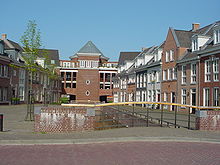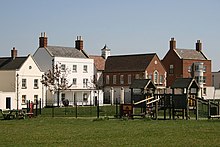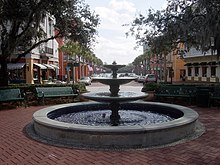New Urbanism

New Urbanism ( " New Urbanism ") is a movement in urban planning in the late 1980s and early 1990s originated in the United States. The enemy of the movement is the so-called sprawl or urban sprawl , i.e. the boundless expansion of cities into suburban settlements. The New Urbanism criticizes the inevitably high level of individual traffic with the corresponding consumption of resources due to the lack of pedestrian friendliness , the high costs for large-scale infrastructure (roads, electricity, sewerage), the urban sprawl and the anonymity of the neighborhoods.
The aim of New Urbanism is therefore to reactivate the form of living in the built-up city with the advantages of short distances, intensive neighborhood and incentives for a healthy life. An important tool for this is the perimeter block development and the avoidance of strict separation of functions , for example according to residential and business districts. There are also large, “lifeless” spaces between the buildings, such as those found in B. planned in loosened settlements with social housing should be avoided. Instead, there should be smaller green courtyards and well-tended parks . Many developments in New Urbanism are also based on the structure of historic old towns with their grown structures.
history


As early as the early 1980s, a number of critical voices were raised against the urban sprawl around American cities. In 1991, the Local Government Commission , a Californian non-governmental organization , brought together experts from the field of urban planning and architecture to formulate concrete practical recommendations for changing urban development. In the same year the group published the so-called “Ahwahnee Principles”, in which the main demands of New Urbanism were already formulated.
The movement was institutionalized in 1993 in the form of the Congress for the New Urbanism (CNU) under the actual name “New Urbanism” . The CNU is a non-profit organization consisting of urban planners, architects, property developers and other people interested in the city. The organization has been organizing an annual congress since it was founded in 1993, which deals with conceptual issues and practical implementation of New Urbanism. At the fourth congress in 1996, the “Charter of the New Urbanism” was formulated, the founding document of the movement.
With the title addition “Congress”, the new urbanists from the very beginning deliberately sought proximity to the Congrès International d'Architecture Moderne (CIAM). An important architectural movement is known under this congress title, which has been trying to promote modernist , functional urban design since 1928 .
In contrast, New Urbanism can be understood as an exact counter-movement. Instead of a separation of living, working and shopping - as required in the Charter of Athens (CIAM) , one of the programmatic documents of the CIAM - in the Charter of the New Urbanism the New Urbanism outlines the ideal of a " city of short distances " with the greatest possible mix of functions in one place.
Principles of New Urbanism
The creed of the New Urbanism movement is to build cities in such a way that sustainable and livable neighborhoods arise. For the advocates of New Urbanism, this can be achieved by orienting themselves towards the ideal of the traditional American small town. Accordingly, New Urbanism is also optionally referred to as “Traditional Neighborhood Design” (TND).
The movement is therefore not concerned with a mere reorientation of the structural design, but - here again analogous to the modernist idea of CIAM - with influencing the concrete coexistence of the residents. Dense development, a wide range of apartments , a mix of pedestrian-friendly streets and squares are also on the agenda, but this is only a means to an end. The aim of New Urbanism is to build places that enrich life and inspire the spirit (“Create places that enrich, uplift, and inspire the human spirit.”). Properly built, places can encourage strolling, encourage people to get to know each other and protect against crime, according to the New Urbanism belief.
"We recognize that physical solutions by themselves will not solve social and economic problems, but neither can economic vitality, community stability, and environmental health be sustained without a coherent and supportive physical framework."
"We recognize that physical solutions alone cannot solve social and economic problems, but just as little can economic vitality, stability of the community and a healthy environment be sustained without a coherent and supportive physical framework."
A more idealistic variant of New Urbanism is New Pedestrianism , founded in 1999 by Michael E. Arth, an American artist, urban, house and landscape designer, futurist and author.
Examples of New Urbanism in the USA
The first example of a community within the meaning of New Urbanism in the United States is from 1979 by Robert S. Davis beplante Seaside in Florida. He and several architects visited historical places in the south of the USA and wanted to convey their atmosphere in the new place. Significantly involved planners and architects were the Americans Andrés Duany , Elizabeth Plater-Zyberk, Robert AM Stern and Steven Holl , as well as the Europeans Léon Krier and Aldo Rossi , and others. Seaside also formed the backdrop for the movie The Truman Show director Peter Weir (1998).
The Disney : - among many other developers - in the 1990s, a known settlement of the New Urbanism has created Group Celebration in Florida, a place with the character of older American small towns, from the environment through water areas held by a fence separated and historicist buildings in the style of the 18th and 19th centuries (" Colonial Revival", "Federal Style", "New Georgian ", "New Victorian ").
New Urbanism in Germany and Europe

In Germany, from the perspective of modernists, the ideas of New Urbanism are mostly equated with an architecture of tranquility and backward-looking aesthetics and are predominantly discredited as “neo-traditionalist backdrop magic”. Nevertheless, there is an initiative with the Council for European Urbanism (CEU) that was founded in Europe and is programmatically oriented towards the US Congress for the New Urbanism . The CEU also has a German section that sporadically publishes the online magazine Die Neue Stadt . In addition, the problem of the boundless outgrowth of cities into the landscape in Europe through traditionally denser building structures, criticized by New Urbanism, is not as pronounced as in North America.
The British version of New Urbanism may seem more creative than the American one; New plans in the English country house style like Poundbury / Dorset in Great Britain seem like islands in a completely different kind of environment characterized by post-war modernism. The settlement on the leasehold of the British heir to the throne Prince Charles is inspired by the design principles that he outlined in his book A Vision of Britain .
In Poland, the Miasteczko Wilanów district of Warsaw is an example of the implementation of ideas from New Urbanism.
Examples and representatives for New Urbanism in Germany
District:
- Kirchsteigfeld , Potsdam , under the direction of Rob Krier and Christoph Kohl
Architects and urban planners:
- Hans Kollhoff , Berlin
- Rob Krier , Luxembourg / Berlin
- Christoph Kohl , Berlin
- Tobias Nöfer, Berlin
- Patzschke Architects, Berlin
- Hans Stimmann , Berlin
- Michael Stojan (New Urban Architecture), Siegen
- Sergei Tchoban , Berlin
- Marc Kocher , Zurich / Berlin
See also
- Driehaus Architecture Prize
- Postmodern architecture
- Reconstruction (architecture)
- Transect (urban planning) (transect according to Andrés Duany)
literature
- Eric Firley / Katharina Groen: The Urban Masterplanning Handbook , John Wiley & Sons, 2013
- Ludger Basten: Postmodern Urbanism. Design in the urban periphery . Münster: LIT, 2005
- Harald Bodenschatz : Old City - newly built. The old town, 25 1998, No. 4, 299–317
- Peter Katz: The New Urbanism: Toward an Architecture of Community. New York et al. a. 1994
- Léon Krier: Architecture of Urban Design 1967–1992. John Wiley & Sons, 1993
- Robert Steuteville u. a .: New Urbanism: Comprehensive Report & Best Practice Guide. 3rd ed. New Urban News, Ithaca 2003.
Web links
- Charter of the New Urbanism (German translation of the English Charter of the New Urbanism )
- New Urbanism- do we need a new urban architecture?
Individual evidence
- ↑ Urbanism Principles. Retrieved August 23, 2009 .
- ↑ Steuteville u. a. 2001, p. 7
- ↑ Evoking the Mayans on a Florida Beach - New York Times
- ↑ HRH The Prince of Wales: The future of our cities - a very personal examination of modern architecture , Heyne Verlag, Munich 1990, ISBN 3-453-04365-0 ; more fundamental: The Prince of Wales with Tony Juniper and Ian Skelly: Harmony - A new view of our world , Riemann Verlag, Munich 2010, ISBN 978-3-570-50129-0
- ↑ Neue Stadtbaukunst, Michael Stojan


